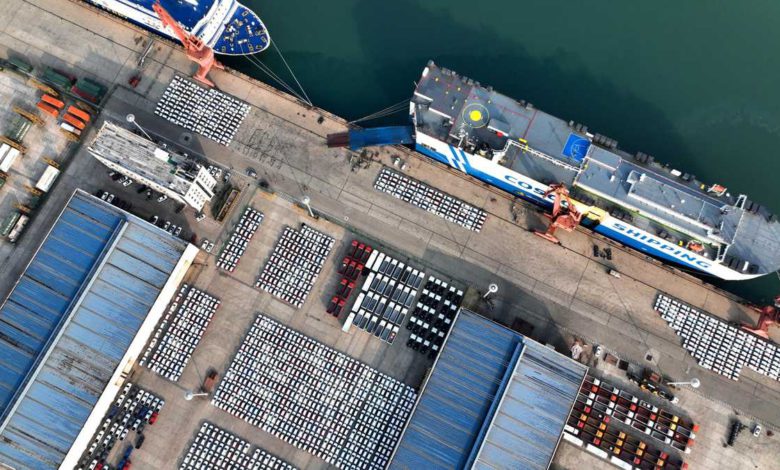

Retailers can breathe a sigh of relief now that the Christmas holiday is over, capping months of laborious planning to keep shelves stocked over the busy shopping period. But it may not be much of a respite.What's happening: A new index from the Federal Reserve Bank of New York that tracks pressure on global supply chains indicated a slight drop between October and November."The seems to suggest that global supply chain pressures, while still historically high, have peaked and might start to moderate somewhat going forward," the New York Fed's researchers said this week.But analysts looking ahead to 2022 aren't convinced conditions will meaningfully improve. They say the impact of the highly contagious omicron variant hasn't been fully realized, especially as some countries in Asia try to suppress all coronavirus outbreaks.Record infections are triggering shortfalls of workers at ports and other transit hubs, while "zero COVID" policies are affecting manufacturers that have been desperate to keep production on track following a surge in demand for goods."Already we're seeing labor shortages right across the supply chain," Martin Dixon, director of research products at the consultancy Drewry, told me.Chipmakers Samsung and Micron have had to adjust operations in the Chinese city of Xi'an, an industrial center that has been under strict lockdown since Dec. 23.Judah Levine, head researcher at Freightos Group, told me that shipping rates for 40-foot containers from Asia to North America's West Coast fell by about 25% in November as "peak season" ended and "have stayed about level since then."They're starting to rise again in advance of the Lunar New Year holiday in February, as consuming countries like the United States stock up on items before factories close in China. Levine doesn't think rates will return to peak season levels. However, he does think they'll stay high "as long as demand stays strong and ports continue to struggle with congestion.""Those will only subside once there is a decrease in consumer spending on goods, which, especially with the current omicron surge, does not look imminent," he said. Retailers are also working hard to rebuild depleted inventories, leading to an increase in orders.A true "back to normal" will happen slowly, likely over the course of 2023, Levine said.Bottom line: A slight moderation in costs from last fall won't make life much easier for companies across the supply chain. Furniture giant Ikea said last week that it would raise prices at its stores by an average of 9% in 2022 to help offset higher costs, including for transportation.Some carmakers have also indicated that they do not expect to be able to ramp up production in the first half of this year due to ongoing shortages of computer chips."Chip scarcity will also accompany us in 2022, particularly in the first half," Markus Schaefer, the chief technology officer of Mercedes-Benz maker Daimler, recently told journalists. "We do not expect significant production capacity increases in the first half of the year."
Retailers can breathe a sigh of relief now that the Christmas holiday is over, capping months of laborious planning to keep shelves stocked over the busy shopping period. But it may not be much of a respite.
What's happening: A new index from the Federal Reserve Bank of New York that tracks pressure on global supply chains indicated a slight drop between October and November.
"The [index] seems to suggest that global supply chain pressures, while still historically high, have peaked and might start to moderate somewhat going forward," the New York Fed's researchers said this week.
But analysts looking ahead to 2022 aren't convinced conditions will meaningfully improve. They say the impact of the highly contagious omicron variant hasn't been fully realized, especially as some countries in Asia try to suppress all coronavirus outbreaks.
Record infections are triggering shortfalls of workers at ports and other transit hubs, while "zero COVID" policies are affecting manufacturers that have been desperate to keep production on track following a surge in demand for goods.
"Already we're seeing labor shortages right across the supply chain," Martin Dixon, director of research products at the consultancy Drewry, told me.
Chipmakers Samsung and Micron have had to adjust operations in the Chinese city of Xi'an, an industrial center that has been under strict lockdown since Dec. 23.
Judah Levine, head researcher at Freightos Group, told me that shipping rates for 40-foot containers from Asia to North America's West Coast fell by about 25% in November as "peak season" ended and "have stayed about level since then."
They're starting to rise again in advance of the Lunar New Year holiday in February, as consuming countries like the United States stock up on items before factories close in China.
Levine doesn't think rates will return to peak season levels. However, he does think they'll stay high "as long as demand stays strong and ports continue to struggle with congestion."
"Those [factors] will only subside once there is a decrease in consumer spending on goods, which, especially with the current omicron surge, does not look imminent," he said. Retailers are also working hard to rebuild depleted inventories, leading to an increase in orders.
A true "back to normal" will happen slowly, likely over the course of 2023, Levine said.
Bottom line: A slight moderation in costs from last fall won't make life much easier for companies across the supply chain. Furniture giant Ikea said last week that it would raise prices at its stores by an average of 9% in 2022 to help offset higher costs, including for transportation.
Some carmakers have also indicated that they do not expect to be able to ramp up production in the first half of this year due to ongoing shortages of computer chips.
"Chip scarcity will also accompany us in 2022, particularly in the first half," Markus Schaefer, the chief technology officer of Mercedes-Benz maker Daimler, recently told journalists. "We do not expect significant production capacity increases in the first half of the year."
Source link








